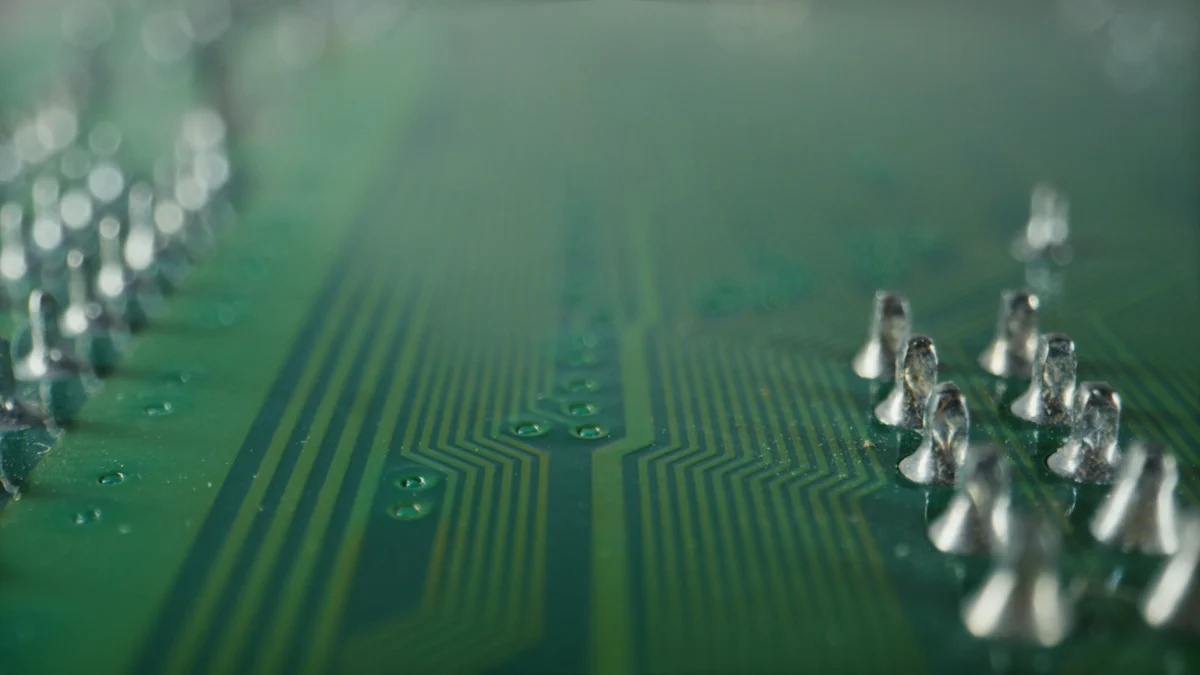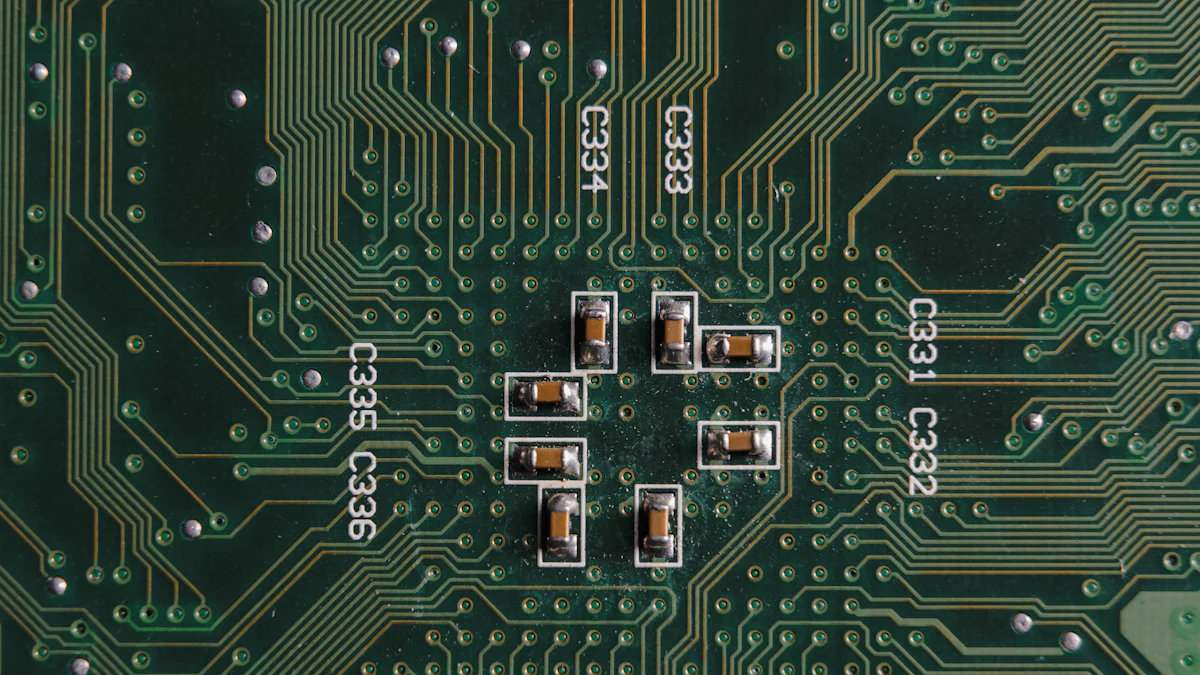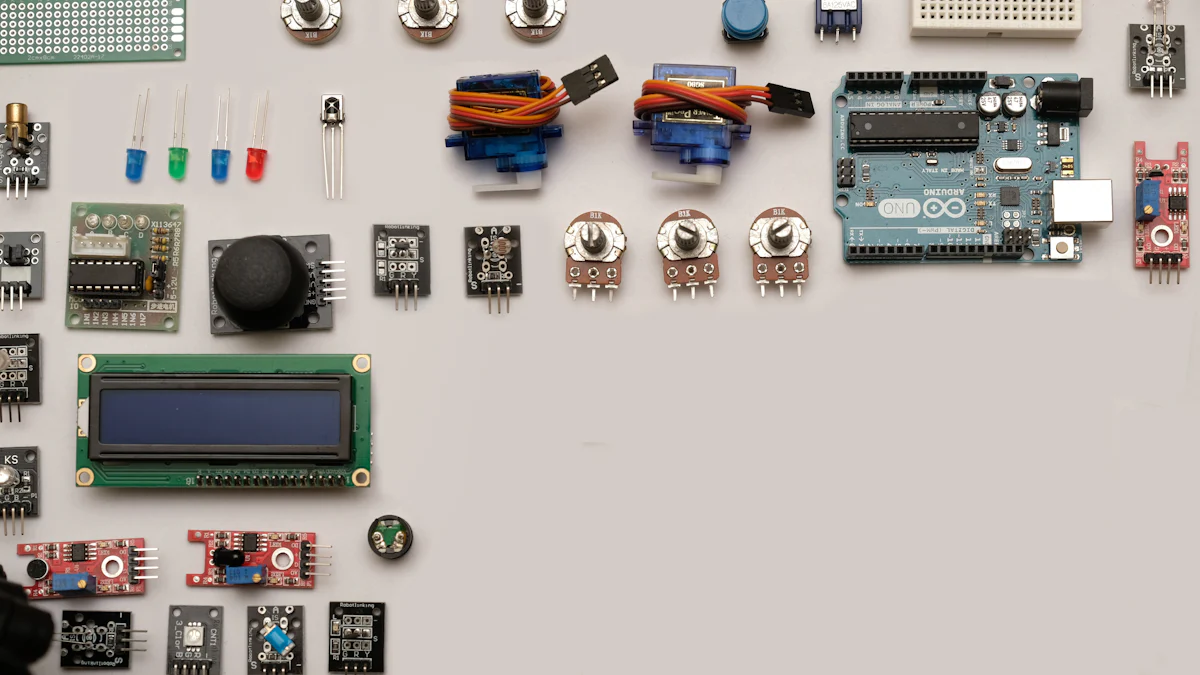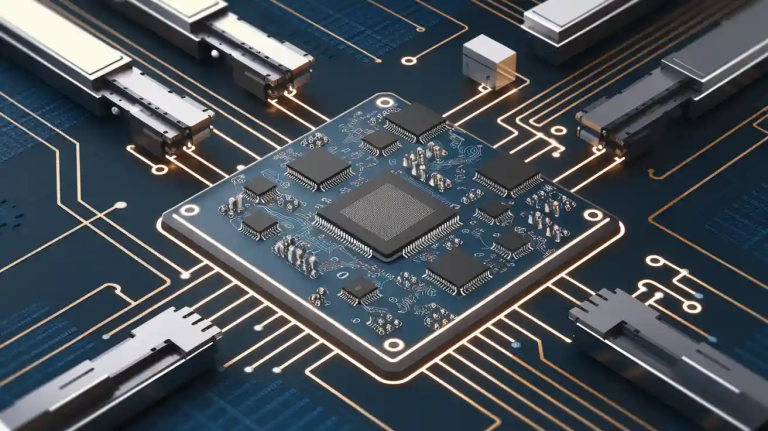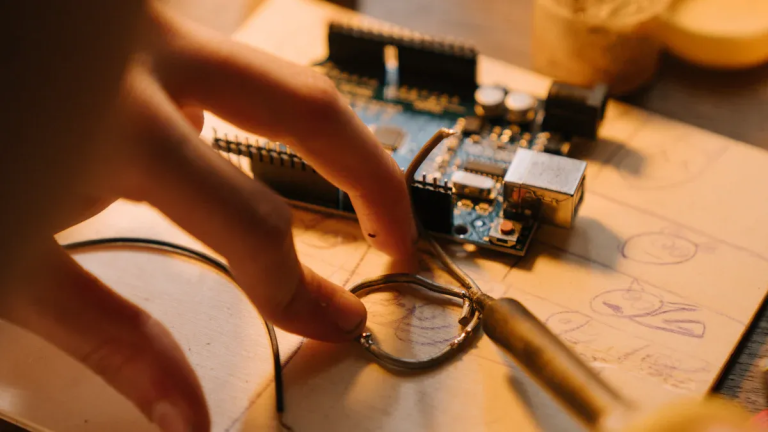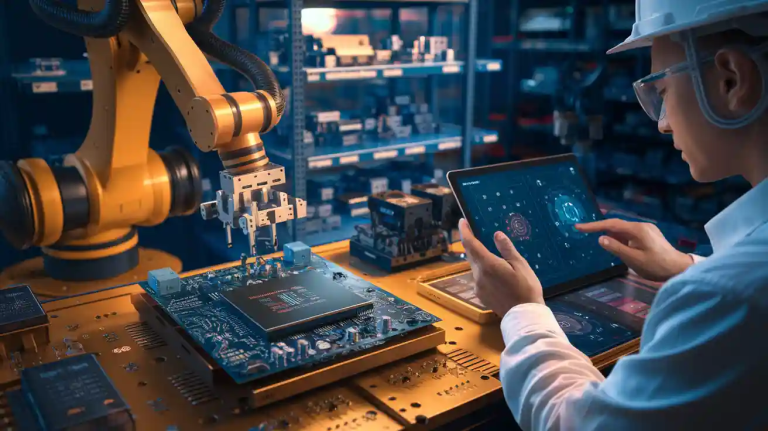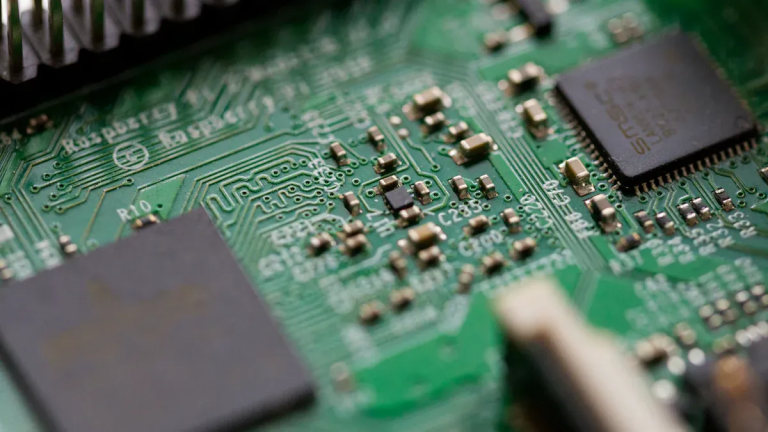The materials you choose for your PCB directly determine its performance and reliability. Every property, from thermal conductivity to dielectric constant, plays a role in how well your circuit boards function under real-world conditions. For instance, a low dielectric loss ensures signal quality in high-speed circuits, while high thermal conductivity prevents overheating, extending the lifespan of your devices.
Selecting the right materials isn’t just about functionality—it’s about ensuring durability and efficiency. Materials with stable dielectric constants maintain signal integrity, while those with high mechanical strength resist wear and tear. By making informed choices, you can create PCB boards that excel in demanding applications and environments.
Tip: Prioritize materials with properties that align with your application needs to avoid costly failures and maximize performance.
Key Takeaways
- Pick PCB materials that match your project needs for best results.
- Use materials with low dielectric constants to reduce signal loss in high-frequency uses.
- Choose materials that handle heat well for powerful devices.
- Think about moisture and rust resistance for tough environments.
- Work with skilled PCB makers to choose wisely and simplify production.
Overview of PCB Materials
Understanding the composition of PCB boards is essential for optimizing their performance. The types of materials used in PCB manufacturing directly influence their electrical, thermal, and mechanical properties. Let’s explore the most common and advanced materials shaping the industry today.
Common Materials in PCB Boards
FR4 (Fiberglass Epoxy Laminate)
FR4 is one of the most widely used PCB materials. It consists of a composite of woven fiberglass cloth and epoxy resin. This material offers excellent mechanical strength, electrical insulation, and cost-effectiveness. Its compatibility with standard manufacturing processes makes it ideal for consumer electronics and industrial applications.
PTFE (Polytetrafluoroethylene)
PTFE, commonly known as Teflon, is a high-performance material used in PCBs requiring superior electrical properties. It has a low dielectric constant and loss tangent, making it perfect for high-frequency and RF applications. PTFE also provides excellent thermal stability, ensuring reliable performance in demanding environments.
Polyimide
Polyimide is a flexible material known for its high thermal resistance and durability. It performs exceptionally well in extreme temperatures, making it suitable for aerospace, automotive, and military applications. Its flexibility also supports the development of compact and lightweight designs.
Metal Core Materials
Metal core PCBs use materials like aluminum or copper to enhance thermal performance. These materials efficiently dissipate heat, making them ideal for power electronics, LED lighting, and automotive systems. Their ability to manage heat ensures the longevity and reliability of high-power devices.
| Material Type | Description | Primary Applications |
|---|---|---|
| FR-4 | Composite of woven fiberglass cloth and epoxy resin. | Widely used in electronics due to cost-effectiveness and compatibility with manufacturing processes. |
| Flexible Materials | Materials like polyimide that provide mechanical flexibility. | Ideal for wearable electronics, medical devices, and aerospace systems. |
| Metal Core Materials | Materials designed for enhanced thermal performance, commonly aluminum. | Used in power electronics, LED lighting, and automotive systems. |
Advanced and Emerging Materials
Ceramic-based PCBs
Ceramic-based PCBs represent a leap forward in material innovation. They offer exceptional thermal conductivity and electrical insulation, making them suitable for high-power and high-frequency applications. These materials are often used in industries like telecommunications and medical devices, where precision and reliability are critical.
Flexible and Rigid-Flex Materials
Flexible and rigid-flex materials combine the benefits of flexibility and rigidity. They are ideal for space-constrained designs, such as wearable electronics and compact consumer devices. These materials also improve durability by reducing the risk of mechanical failure.
Note: Advanced materials like low-loss laminates and high-frequency substrates are transforming PCB stack-up designs. They minimize signal loss, improve thermal management, and enable finer circuit patterns for modern technologies.
Emerging trends in PCB materials include the use of eco-friendly and biodegradable options. These innovations not only reduce environmental impact but also align with the growing demand for sustainable manufacturing practices.
Key Properties of PCB Materials
Understanding the properties of PCB materials is essential for optimizing performance and ensuring reliability. These properties influence everything from electrical performance to thermal stability and mechanical strength. Let’s explore the key attributes that define the functionality of PCB materials.
Electrical Properties
Dielectric Constant (Dk)
The dielectric constant (Dk) measures how well a material can store electrical energy. For high-frequency PCBs, a lower Dk is preferred because it minimizes signal loss and maintains signal integrity. Materials with low Dk values, such as PTFE, are ideal for applications like RF and microwave circuits.
Note: The Dk also impacts the width of conductors. A higher Dk allows for narrower traces, which is crucial for compact designs.
Loss Tangent (Df)
The loss tangent (Df), also known as dissipation factor, indicates how much power is lost as heat during signal transmission. Low Df values are critical for high-speed circuits, as they reduce signal attenuation and improve the signal-to-noise ratio. This property becomes especially important in applications operating above 1 GHz, where maintaining signal quality is paramount.
| Property | Description |
|---|---|
| Dielectric Constant (Dk) | Determines how well a material can store electrical energy; lower values are preferred for high-frequency applications to minimize signal loss. |
| Dielectric Loss (Df) | Measures energy dissipation; low values are crucial for high-speed circuits to maintain signal quality. |
Thermal Properties
Thermal Conductivity
Thermal conductivity is vital for heat management in high-power applications. Materials like copper, with a thermal conductivity of 400 W/m·K, excel at dissipating heat, preventing overheating and extending device lifespan. In contrast, standard materials like FR-4 have much lower thermal conductivity, around 0.3 W/m·K, making them less suitable for high-power designs.
Glass Transition Temperature (Tg)
The glass transition temperature (Tg) marks the point where a PCB material transitions from a rigid state to a rubbery one. Exceeding this temperature can lead to deformation and failure. High-Tg materials, such as polyimide, offer superior thermal stability, making them ideal for applications exposed to extreme temperatures.
Tip: Always select materials with a Tg that exceeds the operating temperature of your application to ensure long-term reliability.
Mechanical Properties
Flexural Strength
Flexural strength measures a material’s ability to resist deformation under stress. This property is crucial for PCBs used in flexible and rigid-flex designs, where bending and mechanical stress are common. Materials with high flexural strength ensure durability and reduce the risk of mechanical failure.
Dimensional Stability
Dimensional stability refers to a material’s ability to maintain its shape and size under varying conditions. PCB materials with high dimensional stability, such as ceramic-based options, resist warping and ensure consistent performance, even in harsh environments.
Callout: Prioritize materials with excellent mechanical strength to enhance the durability and reliability of your PCB designs.
Environmental and Chemical Properties
Moisture Absorption
Moisture absorption is a critical factor that can significantly impact the performance of PCB materials. When exposed to humid environments, PCB materials can absorb moisture, leading to several performance issues:
- Increased dielectric constant, which disrupts signal integrity.
- Reduced insulation resistance, causing current leakage.
- Physical deformation, such as warping or cracking, which compromises structural stability.
Materials like FR-4 have a low moisture absorption rate (0.1% to 0.2%), making them more reliable in humid conditions. In contrast, polyimide absorbs 2.5% to 3.5% moisture, which can lead to faster degradation. Choosing materials with lower moisture absorption rates ensures your PCB remains stable and functional, even in challenging environments.
Tip: For applications in high-humidity areas, prioritize PCB materials with low moisture absorption to maintain long-term reliability.
Resistance to Corrosion
Corrosion resistance is another essential property of PCB materials. Moisture and environmental contaminants can react with metal surfaces, forming oxides that hinder conductivity. This can result in:
- Intermittent faults or complete system failures.
- Accelerated degradation of electrical properties.
- Reduced lifespan of your PCB.
Selecting materials with robust corrosion resistance is vital for ensuring durability. For instance, protective coatings and surface finishes, such as ENIG (Electroless Nickel Immersion Gold), can shield metal components from oxidation. Additionally, materials like ceramic-based PCBs offer excellent resistance to environmental factors, making them ideal for harsh conditions.
Callout: Protect your PCB from corrosion by using materials with strong chemical resistance and applying protective finishes to metal components.
By understanding the environmental and chemical properties of PCB materials, you can make informed decisions that enhance performance and reliability. Whether you’re designing for humid climates or harsh industrial settings, selecting the right materials ensures your PCB withstands environmental challenges.
Impact of Material Properties on Performance
Signal Integrity in PCB Boards
High-frequency performance
The choice of PCB material plays a critical role in maintaining signal integrity, especially in high-frequency boards. Materials with a low dielectric constant (Dk) ensure minimal signal distortion, allowing electrical signals to propagate efficiently. For high-speed digital boards, selecting substrates with a low dissipation factor (Df) reduces energy loss and preserves signal quality.
Tip: Use materials like PTFE for high-frequency applications to minimize signal loss and maintain performance.
Minimizing signal loss
Signal loss can disrupt the functionality of your PCB stack-up, especially in complex designs. Dielectric loss, caused by polarized molecules in the material, increases with frequency. Choosing materials with a lower Df can mitigate this issue. Additionally, copper loss, influenced by the skin effect, can be reduced by using wider copper traces or thicker copper layers. These strategies enhance signal transmission and improve the overall reliability of your PCB.
- Key practices to minimize signal loss:
- Select low Dk materials for high-frequency boards.
- Use thicker copper layers to reduce impedance.
- Optimize the PCB stack-up to support high-speed circuits.
Heat Management and Thermal Performance
Thermal dissipation in high-power applications
Effective heat management is essential for maintaining the reliability of high-power PCBs. Materials with high thermal conductivity, such as aluminum or copper, excel at dissipating heat. Incorporating thermal vias and copper thermal pads into your PCB stack-up can further enhance heat transfer. These features prevent overheating and extend the lifespan of your components.
Preventing overheating and failure
Overheating can lead to PCB failure, especially in demanding applications. High-Tg materials, like polyimide, maintain their mechanical and electrical performance at elevated temperatures. Strategic component placement and the use of heat sinks also help disperse heat away from critical areas. By prioritizing thermal performance, you can ensure your PCB operates reliably under high-power conditions.
Durability and Reliability
Resistance to wear and tear
PCB materials with high mechanical strength resist deformation and wear, ensuring long-term durability. Flexural strength is particularly important for flexible PCBs, which must withstand repeated bending. Materials like FR-4 and polyimide offer excellent resistance to mechanical stress, making them ideal for applications requiring robust designs.
Performance in harsh environments
Harsh environments demand PCB materials with superior reliability. Moisture-resistant options, such as PTFE, prevent performance degradation in humid conditions. Additionally, materials with strong chemical resistance, like polyimide, maintain functionality when exposed to corrosive substances. By selecting the right materials, you can create PCBs that perform consistently, even in extreme conditions.
Callout: For applications in harsh environments, prioritize materials with high moisture and chemical resistance to ensure long-term reliability.
Application-Specific PCB Material Selection
Choosing the right PCB material for specific applications is critical to achieving optimal performance and reliability. Each industry has unique requirements, and understanding these needs ensures your PCB material selection aligns with the demands of the application.
Automotive Applications
High-temperature and vibration resistance
Automotive PCBs operate in challenging environments, requiring materials that can withstand extreme conditions. High temperatures, constant vibrations, and exposure to humidity demand robust PCB materials. For instance, heavy copper layers improve heat dissipation and current handling, making them ideal for high-density electronics like engine control units. Additionally, materials with low dielectric loss are essential for automotive radar systems, ensuring signal integrity in high-frequency applications.
| Property | Description |
|---|---|
| Thermal Cycling | Withstands temperature variations without failure. |
| Thermal Shock | Resists sudden temperature changes. |
| Humidity Resistance | Performs reliably in humid environments. |
| Low Dielectric Loss | Maintains signal quality in high-frequency automotive systems. |
| Heavy Copper | Enhances heat dissipation and current handling. |
| High Reliability | Ensures long service life and safety-critical performance. |
Tip: Prioritize PCB materials with high thermal and mechanical stability to ensure durability in automotive applications.
Aerospace and Defense
Lightweight and high-reliability materials
In aerospace and defense, every gram matters. Lightweight PCB materials reduce payload weight, improving fuel efficiency and performance. At the same time, these materials must meet strict reliability standards to function in extreme conditions. For example, materials like polyimide offer excellent thermal resistance and durability, making them suitable for high-altitude and space applications. Precision in the assembly process is also crucial to avoid errors that could compromise safety.
- Key factors for aerospace PCB material selection:
- Lightweight materials to reduce payload weight.
- High-reliability materials to withstand extreme conditions.
- Adherence to strict quality standards during manufacturing.
Callout: Lightweight and reliable PCB materials are essential for aerospace systems to perform flawlessly under demanding conditions.
Consumer Electronics
Cost-effective and compact designs
Consumer electronics require PCB materials that balance cost and performance. FR-4 is a popular choice due to its affordability and excellent mechanical and electrical properties. For devices requiring better thermal management or high-frequency performance, materials like Rogers or Isola provide a middle ground between cost and functionality. Compact designs also benefit from materials that support finer circuit patterns and higher component densities.
| Material | Cost | Performance Characteristics |
|---|---|---|
| FR-4 | Low | Good mechanical strength, excellent electrical insulation, moisture, and chemical resistance. |
| Rogers | Medium | High-frequency performance, better thermal management. |
| Isola | Medium | Good performance for specific applications, with cost varying based on type. |
Note: For consumer electronics, focus on PCB materials that deliver cost-effectiveness without compromising performance.
By tailoring your PCB material selection to the specific needs of each application, you can ensure optimal performance, reliability, and cost-efficiency.
Medical Devices
Biocompatibility and Precision
When designing PCBs for medical devices, you must prioritize biocompatibility. These devices often come into direct contact with the human body, making material safety a critical factor. Biocompatible materials ensure that PCBs do not cause adverse reactions when exposed to tissues or bodily fluids. This is especially important for implanted devices like pacemakers or wearable health monitors.
- Key considerations for biocompatible PCBs:
- Materials must maintain integrity during prolonged contact with the body.
- They should resist corrosion from bodily fluids.
- They must comply with strict safety standards, such as ISO 10993-1, which evaluates the biological response of medical devices.
Note: The ISO 10993-1 standard helps you determine if a medical device is safe for human contact, ensuring it does not trigger harmful biological reactions.
Precision is equally vital in medical PCBs. Devices like imaging systems, surgical tools, and diagnostic equipment demand flawless performance. High-quality materials with stable electrical properties ensure accurate signal transmission. For instance, low-loss laminates reduce signal distortion, enabling precise data collection and processing.
By choosing the right materials, you enhance both safety and functionality. Biocompatible PCBs protect patients, while precision-engineered designs improve diagnostic accuracy and treatment outcomes.
Tip: Always collaborate with PCB manufacturers experienced in medical applications. Their expertise ensures your designs meet both biocompatibility and performance requirements.
Medical devices save lives. By selecting materials that prioritize safety and precision, you can create reliable solutions that make a real difference.
Cost and Environmental Considerations
Balancing Cost and Performance
Trade-offs between cost and material properties
When selecting PCB materials, balancing cost and performance is a critical challenge. You need to evaluate how material properties like electrical, thermal, and mechanical performance align with your project’s budget. High-performance materials often come with a higher price tag, but they ensure better signal integrity, thermal performance, and durability. On the other hand, opting for lower-cost materials may compromise these essential qualities, leading to potential failures or increased maintenance costs.
To make informed decisions, consider these factors:
- Performance requirements: Define the electrical and thermal needs of your PCB. For instance, high-frequency applications may require low-loss materials, which can increase costs.
- Budget constraints: Limited budgets might force you to simplify designs or choose less expensive materials.
- Delivery time: Urgent deadlines may necessitate faster, costlier production methods.
A structured approach can help you navigate these trade-offs effectively:
- Identify your PCB’s performance needs, such as thermal management or signal integrity.
- Compare material options, from cost-effective choices like FR-4 to high-performance alternatives like PTFE.
- Assess how material properties, such as dielectric constant or thermal conductivity, impact both performance and cost.
- Understand that higher-quality materials may increase upfront costs but reduce long-term expenses.
- Evaluate the manufacturing process to ensure compatibility with your chosen materials.
By carefully weighing these factors, you can achieve a balance that meets both performance and budgetary goals.
Sustainability in PCB Material Selection
Eco-friendly materials and recycling
Sustainability is becoming a key consideration in PCB material selection. Eco-friendly materials like biodegradable substrates, lead-free solder, and water-based coatings are transforming the industry. For example, biodegradable substrates made from cellulose nano-fiber offer an environmentally safe alternative to traditional fiberglass epoxy. Similarly, lead-free solder reduces health risks and environmental contamination.
Recycling also plays a vital role in sustainable PCB production. Using recycled copper minimizes the environmental impact of copper extraction, while recycling programs for old PCBs recover valuable materials like tin and copper. These practices not only reduce waste but also lower production costs.
Reducing waste in production
Minimizing waste during PCB manufacturing is essential for eco-friendly production. Halogen-free materials eliminate toxic emissions, while water-based inks reduce the release of harmful compounds. Collaborating with environmentally responsible suppliers ensures sustainable sourcing and production methods. Additionally, compliance with regulations like the EU’s Restriction of Hazardous Substances (RoHS) ensures that your PCBs meet global environmental standards.
By adopting sustainable practices, you can reduce your environmental footprint while maintaining high-quality production. Eco-friendly PCB materials and recycling initiatives not only benefit the planet but also enhance your brand’s reputation as a responsible manufacturer.
Best Practices for PCB Material Selection
Aligning Materials with Application Needs
Matching materials to performance requirements
Choosing the right PCB material starts with understanding your application’s specific needs. Each material offers unique properties that directly impact performance and reliability. For instance, high-frequency applications demand materials with low dielectric constants to minimize signal loss, while power electronics benefit from materials with high thermal conductivity to manage heat effectively.
To ensure your PCB material selection aligns with performance requirements, consider these critical factors:
- Electrical performance, such as dielectric properties and signal integrity.
- Mechanical properties, including flexural strength and dimensional stability.
- Environmental resistance to moisture, corrosion, and extreme temperatures.
- Cost considerations and compliance with industry standards.
Tailoring your material choice to the application ensures optimal performance and long-term reliability. For example, aerospace applications often require lightweight materials with excellent thermal resistance, while consumer electronics prioritize cost-effective options like FR-4. Matching materials to your needs guarantees a PCB that performs as intended.
Tip: Always evaluate how the material’s properties align with your application’s demands to avoid costly redesigns or failures.
Collaborating with PCB Manufacturers
Leveraging expertise for optimal material choices
Partnering with experienced PCB manufacturers can simplify the material selection process. These experts understand how different materials influence performance and can guide you toward the best options for your application.
Manufacturers can assist by:
- Recommending materials based on electrical, thermal, and mechanical requirements.
- Ensuring compatibility with manufacturing processes and compliance with standards.
- Evaluating environmental factors like humidity and temperature exposure.
Their expertise helps you navigate complex decisions, such as balancing cost and performance or optimizing the PCB stack-up for signal integrity. By collaborating with manufacturers, you gain access to valuable insights that enhance your design’s reliability and efficiency.
Callout: Leverage the knowledge of PCB manufacturers to make informed material choices and streamline your production process.
Testing and Prototyping
Ensuring material suitability before mass production
Testing and prototyping are essential steps in PCB material selection. Building prototypes allows you to validate your design and uncover potential issues before committing to mass production.
Here’s how prototyping benefits your project:
- Validate new PCB concepts early in development.
- Identify design flaws, such as poor thermal management or signal loss.
- Make quick adjustments based on testing feedback.
- Reduce development costs by avoiding expensive reworks.
- Accelerate time-to-market with refined, production-ready designs.
Prototyping ensures your chosen materials meet performance expectations and integrate seamlessly into the PCB stack-up. By addressing issues early, you save time and resources while delivering a reliable product.
Note: Testing your PCB materials during prototyping ensures they perform as expected, reducing risks and enhancing reliability.
PCB materials are the foundation of reliable and high-performing pcb boards. Their properties, such as dielectric constant, thermal conductivity, and mechanical strength, directly influence performance, durability, and cost-effectiveness. Selecting the right materials ensures your designs meet application-specific needs, whether for high-frequency circuits, harsh environments, or compact consumer devices.
By carefully evaluating material properties and balancing them with budget constraints, you can achieve optimal results. Collaborating with experienced manufacturers and conducting thorough testing further enhances reliability and reduces risks. Take the time to make informed choices—your PCB’s success depends on it.
FAQ
What are PCB boards, and why are they important?
PCB boards are the foundation of modern electronics. They connect and support electronic components, ensuring efficient signal transmission. Without them, devices like smartphones, computers, and medical equipment wouldn’t function. Choosing the right PCB materials ensures reliability and optimal performance for your applications.
How do I choose the best material for my PCB boards?
Start by identifying your application’s needs. Consider factors like thermal performance, signal integrity, and environmental resistance. Collaborate with experienced manufacturers to align materials with your requirements. Testing prototypes ensures your choice meets performance expectations before mass production.
Can PCB boards handle high temperatures?
Yes, but only with the right materials. High-Tg materials like polyimide resist extreme temperatures, ensuring durability. For high-power applications, materials with excellent thermal conductivity, such as metal cores, effectively dissipate heat and prevent overheating.
Are eco-friendly PCB materials available?
Absolutely! Eco-friendly options like lead-free solder and biodegradable substrates reduce environmental impact. Recycling programs for old PCBs also recover valuable materials, promoting sustainability. Choosing these options supports green manufacturing practices without compromising quality.
Why is prototyping essential in PCB design?
Prototyping validates your design and material choices. It helps identify flaws, such as poor thermal management or signal loss, early in development. This process saves time, reduces costs, and ensures your PCB boards perform reliably in real-world conditions.


